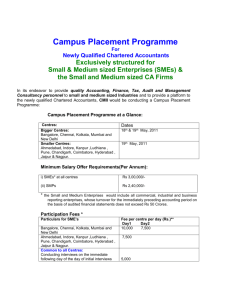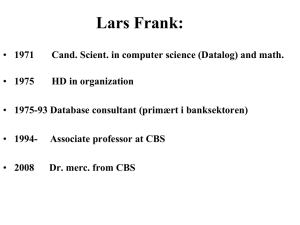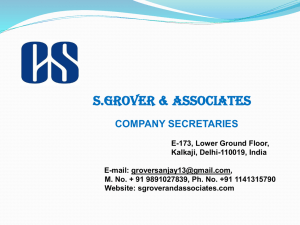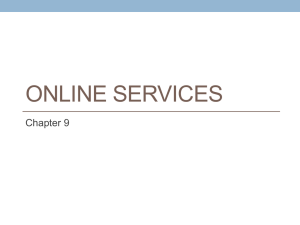View Presentations
advertisement
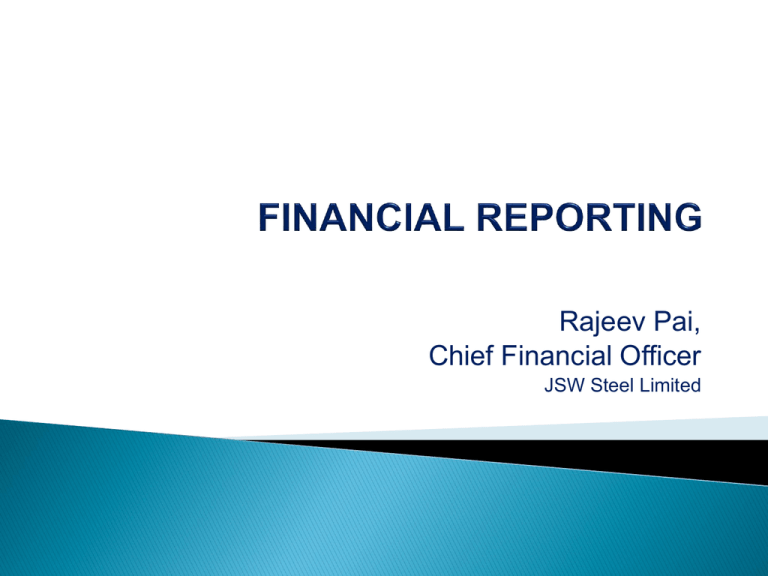
Rajeev Pai, Chief Financial Officer JSW Steel Limited Setting of Enterprise Resource Planning (ERP) based system and key challenges Accounting Standards and Regulatory compliance and Challenges thereof Reporting to owners / shareholders Setting of ERP based Financial system and challenges An ERP system is an attempt to integrate all functions across a company to a single computer system to serve all functions’ specific needs. It provides integrated database and custom-designed report systems. It adopts a set of “best practices” for carrying out all business processes. Integrated financial information Integrated customer order information Standardization and optimization of operational processes Standardization of various information and report Internal Benefits ◦ Integration of information enhances financial and internal controls ◦ A real-time system ◦ Increased productivity and reduced operating costs ◦ Improved internal communication ◦ Foundation for future improvement External Benefits ◦ Improved customer service and order fulfillment ◦ Improved communication with suppliers and customers ◦ Enhanced competitive position ◦ Increased sales and profits Resistance to change Limitation on customization of ERP system due to inconsistency with existing business processes Cost of implementation (hardware, software, training, consulting) and maintenance Impact on organizational structure (front office vs. back office, product lines, etc.) Interface to other software systems Implementation timelines Availability of internal technical knowledge and resources Education and training Implementation strategy and execution Accounting Standards (AS), Regulatory compliance and Key Challenges Why Accounting Standards? - To harmonize the diverse accounting policies and practices in use in India - To enables the users to interpret the reported information in a better way. - Uniform adoption and disclosure of accounting policies AS consists of detailed rules to be adopted for accounting treatment of various items before the presentation of financial statements. AS 1 to 15 1979 to 1995 AS 16 to 29 2000 to 2007 (7) As 30 to 32 After 2007 (Yet to be notified) Statutes e.g. Companies Act, etc. - Schedule VI, Companies (Accounting Standards) Rules, 2006, etc. SEBI / RBI Regulations , etc. Accounting Standard Board (ASB) of Institute of Chartered Accountants of India (ICAI) ◦ Framework ◦ Accounting Standards (AS) ◦ Accounting Standard Interpretations (ASI) ◦ Guidance notes (GN) ◦ Various accounting announcements ◦ Expert Advisory Opinion (EAC) ◦ ICAI Technical Guides ◦ ICAI Monographs ◦ ICAI Research publications Section 210A – Constitution of National Advisory Committee on Accounting Standards (NACAS) Section 211 ◦ P&L, Balance Sheet to comply with the Accounting Standards ◦ Accounting Standards as may be prescribed by the Central Government ◦ Till that time, standards issued by ICAI to be followed Formation of NACAS Committee - Headed by Shri Y. H. Malegam as Chairman and representatives from various bodies viz. ICAI, ICSI, RBI, SEBI etc. NACAS recommended Standards 1 to 7 and 9 to 29 (AS 8 – R&D part of AS 26) IND-AS accounting standard equivalent to IFRS have been issued by NACAS in India however the adoption of these standards have been postponed. Companies Act has amended the presentation of financials statements by issuing Revised Schedule VI for the financial years beginning from 1.4.2011. Revised Schedule VI has brought the disclosure of financial statements more or less in accordance with IFRS. Other Regulatory compliances - - - - - Key Compliances: Adoption of audited annual accounts at AGM and filing (XBRL) thereof within 30 days of AGM Maintenance of register under various section of the Companies Act (example - register of investments, charges etc) Filing of various forms with ROC (like appointment of directors, allotment of shares etc) Compliance with minimum number of board meetings, audit committee (if applicable), shareholder meetings etc. and maintenance of various records thereof Defines power within which Board of directors to act upon Cost Audit Report, if applicable, to be filed within 180 days from end of financial year. Key Compliances: - Transfer pricing – International & Domestic Transfer Pricing - Tax audit and Filing of Annual Income Tax return - Payment of Advance Tax - TDS Compliance Transfer Pricing 19 What is Transfer Pricing Analysis • The process of determining what is the arm’s length price for a transaction (or a group of similar transactions) 20 TP was earlier limited to ‘International Transactions’ The Finance Act 2012, extends the scope of TP provision to ‘Specified Domestic Transactions’ between related parties w.e.f. 1 April 2012 Obligation now on taxpayer to report/ document and substantiate the arm’s length nature of such transactions Transfer Pricing - Domestic Intent of Indian TP Regulations… (Domestic transactions) India India Shifting of expenses/losses Indian Co. Tax Holiday undertaking Tax Exemption Related Enterprise in Domestic Tariff Area (DTA) Tax @33.99% Shifting of income/profits Tax Saving for the Group – Loss to Indian revenue 22 Section 92BA – Meaning of Specified Domestic Transactions (SDT) (inserted by Finance Act, 2012 w.e.f. AY 2013-14 i.e. current FY) For the purposes of this section and sections 92, 92C, 92D and 92E, “specified domestic transaction” in case of an assessee means any of the following transactions, not being an international transaction, namely:(i) any expenditure in respect of which payment has been made or is to be made to a person referred to in section 40A(2)(b); (ii) any transaction referred to in section 80A; (iii) any transfer of goods or services referred to in sub-section (8) of section 80-IA; (iv) any business transacted between the assessee and other person as referred to in section 80-IA (10); (v) any transaction, referred to in any other section under Chapter VIA or section 10AA, to which provisions of section 80-IA(8) or section 80-IA(10) are applicable; or (vi) any other transaction as may be prescribed, and where the aggregate of such transactions entered into by the assessee in the previous year exceeds a sum of five crore rupees. 23 • Computation of Arm’s Length Price by applying the ‘most appropriate’ method out of – Comparable Uncontrolled Price (CUP) – Resale Price Method (RPM) – Cost Plus Method (CPM) – Transaction Net Margin Method (TNMM) – Profit Split Method (PSM) Challenges Type of payments/ transactions • Salary and Bonuses paid to the partners Challenges • Benchmarking? • Whether the limit as mentioned in section 40 (b) would be the ALP? • Remuneration paid to the Directors • Benchmarking? • Whether the limit as mentioned in Schedule XIII would be the ALP? • Transfer of land • Whether the rates mentioned in the ready reckoner be considered as ALP? • Joint Development agreements • Benchmarking? • Project management fees • Benchmarking? • Allocation of expenses between the • Whether these allocation would be SDT – same taxpayer having an eligible Sec 80-IA(10)? unit and non-eligible unit • Directly v/s Indirectly • Definition of Related Party 25 Key Compliances • Service Tax – Applicable on all services except negative list • Excise Duty – Applicable on goods manufactured • Custom Duty – Applicable on import of goods • Sales Tax/VAT – Applicable on Sale of goods (inter state and intra state) Compliance includes timely filing of returns, payment of taxes etc Payment of Service Tax - by 5th of succeeding month - For March month by 31st March ST 3 Returns has to be e-filed half-yearly Period Due Date April to September 25th October October to March 25th April 27 Form Description Who is require to file Time limit ER-1 Monthly return by large units Manufacturers not eligible for SSI concession 10th of following mth. ER-2 Return by EOU EOU units 10th of following mth. ER-3 Quarterly return by SSI Assesses availing SSI concession 20th of following qtr. ER-4 Annual financial information statement Assesses paying duty of Rs. One crore or more per annum through PLA . Annually, by 30th Nov. of succeeding year. ER-5 Information relating to principal inputs Assesses paying duty of Rs. One crore or more per annum through PLA and manufacturing goods under specified tariff heading Annually, by 30th April of current year. ER-6 Monthly return of receipts & consumption of each of Principal Inputs Assesses who is required to submit ER-5 return 10th of following month ER-7 Annual Install capacity statement All assessee Annually on or before 30th April. 28 SEBI Act (Applicable to listed entities ) - Corporate Governance Report (Clause 49) - Quarterly standalone and consolidated financial statements (clause 41) - Shareholding pattern (Clause 35) Others - Compliance with respect to compliance with Factories Act and other applicable labor legislations. - Compliance with Foreign Exchange Management Act. - Compliance with Environment Laws. - Compliance with Employers Provident Fund and Miscellaneous Provisions Act, 1952, Payment of Bonus Act, Payment of Gratuity Act etc. - Ensuring that the financials are prepared in accordance with the measurement and disclosures requirement of accounting standards - Various Assumptions made in preparation of financial statements - Frequent changes in rules and regulations - Multiple Acts/ regulators increase cost of compliance and litigations. For example in case indirect tax, tax is levied at various instances such excise on manufactured, service tax on services and VAT/Sales Tax on sale of goods which can be substituted by a single act like Goods and Service Tax (GST) Act. Govt. of India is already contemplating for implementation of the same. To submit annual report containing Corporate Governance, Business Sustainability Report, Management Discussion and Analysis alongwith audited financial statements. Intimation to shareholders on key updates through press release, advertisement in newspapers etc Maintenance and making available to shareholders of various statutory registers and documents as defined under various laws. Voluntary disclosures like ◦ Guidance on profitability of the company ◦ Current status and key updates to Investor and Analyst through meet. Thank You.


